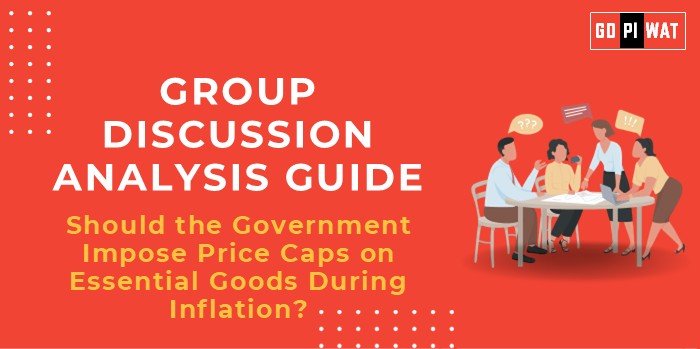📋 Group Discussion Analysis Guide: Should the Government Impose Price Caps on Essential Goods During Inflation?
🌐 Introduction to the Topic
- 📌 Context Setting: “Inflation erodes purchasing power, making essential goods less affordable for many. Governments often consider price caps to shield citizens from escalating prices.”
- 📌 Background: Price caps are regulatory measures that set maximum allowable prices for goods, aiming to ensure affordability during inflationary periods. While they can provide immediate relief, they may also lead to unintended consequences like market distortions and supply shortages.
📊 Quick Facts and Key Statistics
- 📈 India’s Retail Inflation (October 2024): 6.21%
- 🌾 Food and Beverages Inflation (October 2024): 9.7%
- 🌍 Global Practices: Over 40 countries implemented price controls during the 2022 inflation surge.
- 💵 India’s Middle-Class Spending: High food inflation has led to reduced spending on items ranging from cookies to fast food, affecting earnings of major consumer goods companies.
🤝 Stakeholders and Their Roles
- 🏛️ Government: Implements and enforces price caps, monitors compliance, and manages subsidies or stock supplies.
- 🏢 Businesses: Adjust pricing strategies to comply with caps, potentially facing reduced profit margins.
- 👨👩👧👦 Consumers: Benefit from capped prices, gaining access to essential goods at affordable rates.
- 🌾 Producers/Farmers: May experience decreased revenues due to capped prices, necessitating compensatory mechanisms.
- 🌍 Global Markets: Price caps can influence international trade dynamics, especially if export restrictions are imposed.
🏆 Achievements and ⚠️ Challenges
Achievements
- 💡 Short-Term Relief: Price caps on onions in 2023 reduced price surges by 15% within two weeks.
- ⚖️ Economic Stabilization: Prevented major social unrest during the 2020 COVID crisis when food inflation exceeded 9%.
- 🌍 Global Models: France’s “Anti-Inflation Basket” mitigated food price surges effectively.
Challenges
- ⚠️ Market Distortions: Price caps on wheat in 2022 led to hoarding and supply shortages in India.
- 📉 Burden on Producers: Studies indicate farmers lose ~20-30% revenues under caps.
- 🌐 Global Comparisons: Zimbabwe faced black markets after imposing severe price controls in 2021.
📖 Structured Arguments for Discussion
- Supporting Stance: “Price caps ensure affordability for vulnerable populations during inflationary periods.”
- Opposing Stance: “Price caps disrupt supply chains, leading to long-term inefficiencies and potential shortages.”
- Balanced Perspective: “While price caps provide immediate relief, their effectiveness depends on complementary measures like subsidies and efficient enforcement.”
🗣️ Effective Discussion Approaches
- 📊 Opening Approaches:
- Data Highlight: “With inflation hitting 6.21% in India, the affordability of essential goods is a growing concern for the middle and lower-income groups.”
- Global Reference: “Countries like France and South Korea have balanced price caps with subsidies to stabilize their markets during inflation.”
- 📌 Counter-Argument Handling:
- Hoarding concerns? Implement technology-driven supply monitoring systems.
- Revenue loss for producers? Subsidize production costs to offset price caps.
📈 Strategic Analysis: SWOT Framework
Strengths
- Immediate affordability for consumers.
- Political goodwill and public support.
- Social stability during economic crises.
Weaknesses
- Risk of supply shortages.
- Potential for hoarding and black markets.
- Adverse effects on producers’ revenues.
Opportunities
- Digitize cap enforcement for greater efficiency.
- Integrate subsidies to support producers and stabilize markets.
Threats
- Dependence on imports for certain goods.
- Prolonged inflation pressures undermining market stability.
🎓 Connecting with B-School Applications
- 🌍 Real-World Applications:
- Operations: Study supply chain disruptions caused by price caps.
- Finance: Analyze cost structures under inflation control policies.
- Development: Assess socio-economic impacts of price control mechanisms.
- 📚 Sample Interview Questions:
- “What are the long-term economic impacts of price caps during inflation?”
- “How can technology improve the effectiveness of price controls?”
- 💡 Insights for Students:
- Examine international strategies for managing inflation.
- Explore supply chain resilience under capped pricing.


